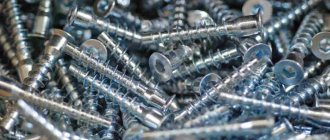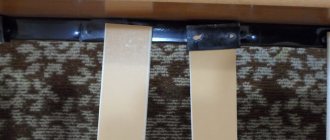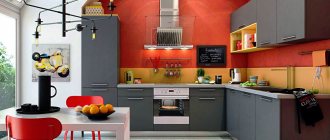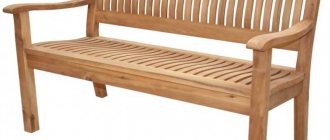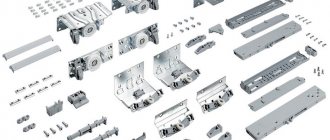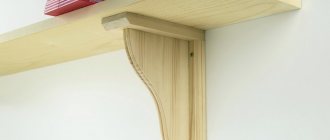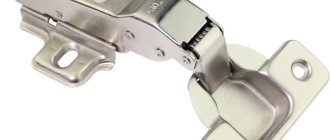When performing a wide range of repair and construction work, it is impossible to do without the use of various fasteners. The modern construction market offers a wide range of these products, which are necessary for high-quality solutions to various technical and technological problems. Their functional purpose can be completely different - from fixing a board with a simple nail, to installing an anchor that must withstand increased operating loads.
This material will discuss the main types of fasteners, various classifications, GOSTs, markings and areas of their application. They come in a wide variety of shapes, sizes and purposes - the most common today are:
- nuts;
- dowels;
- anchors;
- screws;
- self-tapping screws;
- rivets;
- hairpins;
- washers and others.
Depending on the thread pitch, fasteners are metric or non-metric (adapted).
In addition, there is another classification of fasteners - it is based on other criteria. According to it, these elements are:
- threaded, increased strength;
- fasteners for mass use;
- fasteners for shockless fixation and one-sided installation;
- elements for hermetic structures;
- fasteners necessary for fastening polymer composite materials.
This classification, although it significantly simplifies the sorting process, is conditional, since elements of one group may also belong to another. Let's take a closer look at the main ones.
Nails
Perhaps today there is no master who would not use nails in the process of his work. This is the most ancient and widespread fastening material today, which is widely used in many sectors of human economic activity. The material of their production is usually steel or steel types of wire. The nail marking consists of two numbers:
- rod diameter;
- its length (in mm).
The heads of these elements can be either smooth or corrugated, and screw and club nails can have helical, longitudinal and transverse grooves, burrs or dents on the shaft. Such products provide significant resistance to pull-out processes.
Depending on the technical characteristics of the material, the scope of use of nails also differs. For example, hardened steel products can be safely driven into brick or concrete walls. However, when working with them, you should pay attention to the high fragility of this material. In order to attach them to hard surfaces, it is necessary to use wallpaper, roofing felt and plaster types of nails. They are produced with flatter and wider caps than usual, as well as shorter stems. In aggressive environments, copper nails, which are practically not subject to corrosion processes, as well as galvanized nails or alloy steel products can be used.
As for the technological features of driving nails, they also have their own specifics. These processes require taking into account certain nuances, so we recommend using our professional advice:
- to prevent the occurrence of dents while driving nails, it is necessary to use a countersink;
- to ensure fixation strength, the fastening rod must be at least 2/3 of the length included in the lower fixed part;
- when driving small nails, it is best to use special auxiliary accessories;
- To increase the strength of joints, nails should be driven in at an angle rather than straight. The same applies if you need to hang something on it;
- if the nail went through the wall when driving, it should be carefully bent and polished using a triangular file;
- to prevent damage to surfaces when pulled out with pliers, you simply need to place a plate under them that reduces the pressure;
- if in the future you plan to dismantle the parts, then it is better not to use nails at all, giving preference to screws.
Very often, liquid nails can be used during the work process. They are made of polymer materials and rubber and are able to provide adequate fastener strength indicators no worse than traditional nails. One drop of such a substance can withstand up to 50 kg of load, but their main advantage is the complete preservation of the integrity of decorative surfaces.
The scope of use of liquid nails is very wide. They are used for fixing various panels, drywall, chipboard, fiberboard, plywood, cardboard, ceramics, stone, stucco, glass and much more. However, when choosing these fasteners, it is necessary to pay special attention to adhesion indicators, since different types of material have different degrees of adhesion. They are most appropriate to use when:
- temperature not lower than -90 С;
- high indoor humidity.
For example, some types of neutral nails are harmless because they are based on water, but they are not suitable for gluing metal. Liquid nails based on organic solvents have a high setting speed and can withstand temperatures down to -25 °C. Their only drawback is the presence of harmful volatile components that emit unpleasant odors for 5 days.
The setting of such nails occurs within 10-40 minutes, depending on the type and marking, but complete polymerization occurs only after 24 hours.
What are hardware and what are they used for?
Hardware is the name of fastening elements that are made from various materials. Most often, metal, plasterboard or wood are used in their manufacture.
There are a wide variety of hardware in terms of shape and purpose. Among them are such products as:
- cylindrical threaded screws for fastening two or more materials;
- bolts that can fasten any structure using a nut;
- Self-tapping screws are used for fastening soft materials. Their main feature is a sharp thread, which is easily screwed into the thickness and creates reliable contact;
- washers or nuts are used as an additional platform to prevent the bolts from unscrewing during operation;
- studs have double-sided threads and are used to secure two elements;
- anchors or cotter pins are used in construction to join metal or wooden material with a concrete or brick surface;
- nails have a pointed shape and a head. Their feature allows you to manually fasten soft materials;
- anchor plates secure window elements. With their help, windows are securely fastened in openings and at the same time the level of thermal expansion in the home is easily adjusted.
All of the above items refer to lightweight fasteners. All other hardware products have a large shape and are intended for serious purposes in construction or repair.
Types of hardware
Hardware products are formally divided into two groups: industrial and household.
Industrial products are fasteners that are made in production and are universal in their functionality . This type of hardware includes bolts, nuts, anchors , nails, etc.
In the domestic sphere, fastening materials can be paper clips, scissors, knives, forks, buttons, shovels and other elements that are capable of fastening soft materials or are not intended for fastening at all, but still this is a group of hardware.
It is worth paying attention to the purpose of using hardware products. They are used in construction and repair. In addition, hardware takes an active part in the automotive industry. As a rule, it takes about 5 thousand fasteners to assemble one machine.
In furniture factories, when assembling equipment or even clothing, various types of industrial hardware are used.
This is interesting: Do-it-yourself interior arch made of plasterboard in a house or apartment? Step-by-step instruction
Self-tapping screws
Self-tapping screws also occupy a special niche among fasteners. There are not so many varieties of them on the modern market - a full classification is possible only according to 3 main criteria - the material into which they are screwed, size and functional purpose. According to the first criterion, the following types of self-tapping screws are distinguished:
- for metal;
- for wood.
Both products can have different lengths, widths, diameters, as well as different thread pitches. Typically, self-tapping screws for metal surfaces have a fine thread pitch, unlike “wooden” ones, which have a larger thread pitch.
Products for metal can be of several types - self-tapping and those that require preliminary drilling of the metal. The first type has a special drill at the tip, the size of which indicates the thickness of the metal into which it needs to be screwed. An example of such self-tapping screws are tex, which are used to fix gypsum plasterboard profiles. As for their second subgroup, it includes black self-tapping screws, which are necessary for attaching gypsum boards to the metal profile.
In addition, the classification of self-tapping screws can also be carried out according to their functional purpose. For example, there are self-tapping screws for roofing and general purpose. Roofing ones have a wide cap with a press washer, which is necessary to seal the hole to prevent water leakage.
Nuts, washers and screws
These three hardware can be classified in one section, since they belong to the category of fixing ones and do not work as separate fasteners. Let's start with the simplest element - the washer. This is a round product that is attached to a bolt and installed under the nut. The washer prevents the nut from unscrewing and in some cases closes the empty space if the hole into which the bolt is inserted is larger than the diameter of the bolt itself. Washers, despite their simplicity, may differ in the material from which they are made. The most common nuts are made of metal, but there are also rubber and plastic elements. They are used when fastening products that require careful handling of the surface. For example, painted corrugated sheeting is screwed through a rubber washer. It provides a tight connection, but unlike metal, it is not capable of harming the painted surface.
Grover is one of the types of fastening washer. This is a metal ring, sawn on one side and bent in a spiral. When tightened with a nut, the ring takes its original shape, thereby creating tension, that is, providing better clamping. Grovers are made of a stronger grade of steel, and after unwinding they bend again, which allows them to be used repeatedly. The purpose of the Grover is to prevent unwinding, that is, the same as a regular washer. But the grower, due to its shape, can work under heavy load and provides a reliable connection during vibration. Grovers are used in mechanical engineering and on various machines, that is, wherever vibration is present. If you tighten the nut without a screwdriver, it will simply come loose over time.
Nuts are the most diverse hardware in this category. They serve to fix threaded fasteners, that is, they are screwed onto a bolt or screw. In addition to the size and thread pitch, the nuts differ in shape, and the list of configurations is quite large:
- Straight hex nuts. The most common type of hardware, found most often.
- Crowned. It has grooves on the top into which, after tightening, a special cotter pin is inserted to prevent unwinding.
- Lamb. A nut with special protrusions that allow it to be tightened without using a wrench. Used for fastening objects that do not experience heavy loads and with minimal vibration.
- Square. A special nut inserted into a special groove. It does not need to be held with a key when tightening, since it is already fixed in the mounting hole.
- Flanged. The lower part of the nut has a skirt with notches. When twisted, it provides a more reliable grip on the puck or groover.
This is not a complete list of nut form factors, and many modern equipment manufacturers use their own designs, as is the case with the shape of screws and screws.
Anchors: types and features of application
An anchor is a fastening element that is designed to fix various structures and materials. In addition, this name characterizes parts partially concreted into any concrete product. Depending on the design, shape and purpose, the following types of anchors are distinguished:
- ceiling;
- driving;
- wedge;
- frame;
- anchors with half rings and rings;
- anchors with nuts.
They are united by a common function - fastening. For example, drive-in anchors with internal threads and a cone-shaped wedge are necessary to fix various products and materials to a brick or concrete base. It is installed quite simply: it is fixed into a pre-made hole. Its radius and depth are selected depending on the size of the anchors themselves.
Wedge-shaped products are used for quick fastening of planks, profiles, and suspended ceilings in concrete. These types of anchors are very often used to secure heavy equipment to a solid base. For high-quality installation of wedge anchors, a hole is drilled in the concrete base, into which the product is hammered using a hammer, which is subsequently tightened with nuts. As for ceiling anchors, they can be made of galvanized steel, and are necessary for fixing metal profiles, facades, railings, gratings and other products on a concrete or stone base without cracks. Frame anchors are necessary for attaching frames and wooden door frames to concrete walls.
A lot of users try to use this type of fastener for other purposes. For example, they are attached to brick walls, as a result of which the fastening element and nerves deteriorate. But the main thing is the very large holes that remain in the brick after the anchor is removed. They are used, as a rule, in concrete materials, while in soft materials such bolts tend to simply turn. Classification of anchors is also a very difficult task, since products can belong to different groups at the same time, but usually there are three types:
- fastening;
- hook-shaped;
- loopback
The first type is universal, the second is designed for hanging objects, and the third is for catching something. In addition, these fasteners can be divided into the following main groups - with a wedge at the end and with a wedge in the form of a nut. Anchors are manufactured in fixed sizes - the smallest have a length of 50 mm and a diameter of 6-8 mm, the largest - up to 500 mm and a diameter of up to 22 mm.
Tip: the question of how to install an anchor can be solved very simply. To do this, you simply need to select the correct diameter of the hole - you need to drill with a drill of exactly the same size as the anchor itself - you can’t expect that a 12 mm bolt will hold in a 15 mm hole. It is also not advisable to wrap anything around the anchor, it does not make any sense - just insert it into the hole and tighten it with a screwdriver.
Anchors and dowels
Anchors and dowels have a similar design and operating principle. A conical element is inserted into the drilled hole, after which the fastener itself is hammered in, expanding the sleeve and securely fixed in the wall or block. Structurally, dowels are not very different from anchors. The dowel consists of two parts:
- Sleeves, often made of plastic,
- And directly the fastener, often a regular screw.
The design of the sleeve is such that in the uncompressed position it completely corresponds to the diameter of the drilled hole, but when the fasteners are driven in, it expands, and it is almost impossible to pull it back out.
The anchor design is somewhat different. A bolt passes through the body of the hardware, and the steel sleeve has petals at the end. A drop-shaped element is used as a nut, which, when tightening the bolt, opens the petals and securely fixes the anchor inside the hole. In addition to size, anchors differ in the shape of the sleeve. The range of such products is very diverse, and each anchor has its own purpose. For example, butterfly anchors are designed to be installed in full holes, such as through floor slabs. The petals of such an anchor not only expand, but move apart to the sides, thereby preventing the sleeve from falling out of the hole.
If we draw a line between dowels and anchors, we can say that the former are designed for fastening objects with minimal load, while the anchor is able to withstand serious stress. But even here there is a digression - construction-drive-in dowels. Essentially these are nails with a tightly fitted washer. They are driven into concrete with a special gun, and it becomes almost impossible to remove the clogged hardware. These fasteners are also called dowels, although it would be more correct to classify them as construction nails, since they do not have an expanding sleeve and are held in place only by hammering.
Dowels
These fasteners are also extremely popular in the modern construction market. They are necessary for high-quality fastening of various objects and materials to solid structures. There are three types of dowels:
- metal ones are the most ancient. They can be used on almost all surfaces, however, using a simple hammer it is problematic to hammer them, especially into hard materials - therefore, pneumatic, electric or cartridge guns are more often used. Such dowels differ from each other only in diameter and length;
- installation ones are the most common today. They can be manufactured in two variations, which differ from each other in the shape of the plastic tip. In some cases they are mounted in a specially prepared chamber, but in others they are not (the plug has a mushroom-shaped shape). Such dowels are installed using a hammer drill - a hole is made, and then a plastic plug is inserted into it, into which a steel nail is driven or screwed. If necessary, you can then very easily unscrew it thanks to the special thread. Depending on the diameter, dowels are 6.8 - 14 mm, and lengths - 30-300 mm;
- spacer (Bierbach dowel) - made of steel and demonstrate high performance characteristics for use in concrete foundations. They consist of two wedges that are connected to each other in a movable way using a washer. They are mounted in pre-drilled holes, in which they are then wedged with one impact force of a hammer.
They are usually used for fastening in solid wall structures. The fixation of the dowel is based on the frictional force that occurs due to the spacer of the fastener during installation with the appearance of a holding force. The dowel can withstand increased static loads - when installed, the fasteners are destroyed during the pulling process.
The product itself is made of polymer materials. Their physical and mechanical characteristics can be greatly transformed, depending on various influences and conditions. These include, first of all, the parameters of the filler, the ratio of the components of the polymer material, and the properties of the binder. The disadvantages of polymer dowels include low heat resistance, a tendency to deform under load, and increased aging. Only screws can withstand maximum loads if they are correctly selected for the dowel. They must have all parameters (length and diameter) that fully correspond to the parameters of the dowels. The use of other fasteners places increased demands on the thread profile, since they determine the spacer effect. It is undesirable to use self-tapping screws and self-tapping screws to secure drywall.
Boiler
Water heaters of different shapes and sizes are more relevant today than ever. A storage electrical appliance can have significant weight, so it is necessary to choose the most optimal option among the possible installation methods.
Installation on a wooden bookmark
It’s good if the apartment owners planned the installation of this equipment in advance. In such cases, as a rule, the parameters and weight of the boiler are taken into account. And when repairing or finishing a wall with plasterboard, an embedded beam is added to the frame made of profiles. The structure, reinforced with hardwood boards, will easily support the entire weight of the water heater. To install a unit whose weight varies within 50 kg, you must:
- Use a drill to make a hole in the embedded beam through the drywall.
- A dowel is inserted into the wood through the plasterboard and a screw, hook or bracket is screwed in (the latter must be selected for a specific boiler model; in addition, some water heaters are sold with a set of fasteners).
- The same process is repeated at all attachment points.
- The installation sites of fasteners are treated with silicone, because... During their installation, small gaps are formed, which can become a place for moisture to enter.
- The boiler is hung on well-fixed screws, brackets or hooks. If we are talking about equipment of significant weight and size, it is worth considering the option of using anchor bolts.
Installation on pre-assembled metal mount
Quite often there is a need to install a massive multi-capacity water heater. In order not to doubt the strength and reliability of wooden bookmarks, you can safely use metal fasteners made of steel plates and cut screws or bolts:
- A bolt is welded to the plate in the center, and its length is equal to the sum of the width of the profile, the thickness of the drywall, tiles and the required length for proper fixation of the boiler lugs with nuts.
- The required number of parts is made, usually 4.
- The resulting structures are attached to the wall or backfill so that the bolt (welded) is located exactly in the center of the future hole for attaching the water heater.
- The gypsum board wall is sheathed so that the ends of the screws come out - holes are made.
- Any facing material can be laid on top of the plasterboard sheathing.
- When the finishing work is completed, the boiler mounting eyes are put on the prepared bolts, where they are secured with nuts of the appropriate size.
It is clear that this method of installing a water heater is only possible before installing drywall.
Shelf installation
The method is one of the most reliable and safe. In this case, the shelf is made independently from plasterboard or a ready-made product is taken that is suitable in size. It is best if the structure is made of durable material and is fastened to metal profiles, which makes it possible to evenly distribute the weight along the frame stiffeners.
- At the height required for installing the boiler, holes are made to secure the shelf.
- The dowels are inserted into the holes.
- Screws are screwed in and a shelf is hung on which the water heater is installed.
This is how, thanks to a simple design, you can evenly distribute the entire load over the entire section of the wall or onto the floor and wall.
Using a chemical anchor
This method is applicable for installing heavy and large boilers. The scheme of actions is basically similar to the previous ones:
- In the places of future fastening, holes are made in the wall according to the markings through the gypsum board.
- Each hole is thoroughly removed from dust.
- Using a construction gun, a chemical anchor solution is injected.
- Using a pin, the mesh sleeve is tightly inserted into the hole.
- After removing the pin, the hole is refilled with a chemical anchor.
- Let the solution “settle” for 5 minutes and the pin is screwed into the elastic material until it stops.
- After a day, the solution hardens well and the fasteners are ready to install a water heater on it.
Fastening of light water heaters
All boilers are different in weight and size - as a result, the mounting holes for all are at different distances. To install the boiler:
- Markings are made on the plasterboard wall, each of which can be covered with tape to avoid a large amount of dust and debris during further work.
- Holes of the required diameter are drilled in the drywall and profile.
- Dowels are installed in the holes, and then hooks or brackets are mounted.
Having become familiar with the different types of dowels and their capabilities, it is easy to determine how to install various other interior items, decorative elements, etc.
Drywall fastening: molly
For high-quality fixation of gypsum board sheets, there is only one group of fasteners, which is called “molly”, received from the company that developed this fastener. It consists of two parts - an empty folding tube with special slots, a nut and a screw. As the screw is tightened, the tube is assembled and crimped on both sides of the gypsum board. There are two types of molly:
- metal;
- plastic.
The first type is the most reliable - it is installed using special pliers, and to install plastic ones, you need to pre-drill holes with a diameter of 8 mm, insert fasteners into them, and then tighten the screws. Using such elements, only light objects can be hung on drywall - if it is necessary to fix heavy ones, then embedded profiles should be provided.
Advantages of stainless steel fasteners
To fasten structures and equipment, professionals recommend using stainless steel fasteners. Nuts, studs, bolts and screws made of stainless steel are characterized by high consumer properties.
Stainless steel fasteners have a high degree of resistance to corrosion. A huge advantage is also the resistance to metal oxidation both under normal conditions and in environments of high acidity and high temperatures. Stainless steel products can withstand high physical pressure, which contributes to their long-term use. In addition, stainless steel fasteners have a high level of resistance to fire and temperature changes. Even a fire will not damage stainless metal. Thanks to their shiny appearance without rust or plaque, even after long-term use, elements of such fasteners do not require replacement or repair, therefore they are widely used both in public and private places.
Thanks to its properties, stainless steel fasteners have become indispensable in the pharmaceutical and food industries, as well as in the production of medical equipment. Considering all the advantages of stainless fasteners, it becomes clear why today users choose it.
Return to list
Bolts
Bolts are cylindrical fasteners that have a metric cylindrical external thread and a head that is designed to fit a nut. They make it possible to create connections using nuts or pre-made threaded holes in fixed parts. They are in form:
- stepped, in which the thread diameter is smaller than the diameter of the smooth part;
- foundation ones, which have a specially shaped head that helps secure equipment and units to the base;
- with a hexagon-shaped head for a wrench - this is the most common design option.
A bolt is inserted into a pre-prepared hole in the parts that need to be fastened, after which a nut is screwed onto the thread and the elements are tightened using a wrench. The connection is fixed due to friction - but in order to transfer part of the loads to the bolt, it is necessary to ensure maximum precision in the production of the rod and the holes for it. To prevent deformation of parts, washers are installed under the bolt head and nuts. Bolts are always used in combination with nuts.
Hairpins
A stud is one of the simplest types of fasteners in structural terms. This is a straight metal pin, fully or partially covered with threads. It is screwed into the seat and allows you to fasten two objects or fix them with a nut. Hairpins are used in mechanical engineering and in the production of various machine tools, but there are other varieties. For example, plumbing studs. Their peculiarity is that the threads on the two ends are different. That is, on one side it is a screw, and on the other it is a regular bolt. This pin allows you to attach various plumbing products, such as toilets, to concrete surfaces. Having secured one part into a concrete or wooden floor, a bolted part remains outside, onto which a nut is subsequently screwed.
Depending on the purpose and scope of application, studs can be either ordinary, metal, that is, without special coating, or protected. There are many types of protection, as well as methods for applying them. The most common type is zinc. It is applied to the surface of the hardware using the galvanic method and prevents corrosion.
Nuts: types and principle of operation
Nuts are also a very popular type of fastener, which is distinguished by a specially cut threaded connection inside the hole. Galvanized products are the most widely used, and their shape can be completely different - hexagonal, round with notches, square, with protrusions for gripping with fingers. The main functional purpose of a nut is to connect parts using bolts. They are:
- hexagonal;
- square;
- in the shape of a “lamb”;
- flanged with grooves for a cotter pin in the form of a cap;
- T-shaped, with special plastic inserts.
In addition, nuts are also divided into strength categories according to the types of bolts with which they are used.
OTHER TYPES OF METRIC FASTENINGS
- A bolt is a rod with a square or hexagonal head and threads for screwing on a nut. They produce elements with full and incomplete threads. Products of the first type are used to connect several parts at the same time. Furniture bolts are distinguished by a round head and a headrest or a mustache at the bottom.
- A screw is a metal rod with a slot for a screwdriver, with a semicircular or countersunk head. Fasteners are designed to secure parts to the base.
- The metric stud is made with a double-sided thread, one part of the element is screwed into the main surface, and the other into the hole of the part, then a nut is screwed onto it. Sometimes the parts to be fastened are fixed using a stud, onto which nuts are screwed on both sides. Metric studs are also in demand when constructing suspended ceilings.
- Fastening nuts are used in pairs with a bolt or screw; they can be supplemented with a special cap for decoration and protection against dust penetration. There is also a special product - an extension cord, which is used to connect several bolts together. To protect fasteners from corrosion, a zinc or chrome coating is used. The cost of processed products is higher, but their service life is also many times longer than their untreated counterparts.
Rivets
Combination type blind rivets consist of an aluminum body and a rod, which is made of galvanized steel. This design feature is one of the most common and in demand today. Rivets are used to connect two or more surfaces of thin sheets - with their help, a permanent connection is created. Also on the modern market there are rivet nuts. These are fasteners widely used in electronics and mechanical engineering. They are needed to create threaded connections in metal materials or other thin surfaces that have high strength.
Among the large selection of these fastening products, one of the most durable are threaded steel rivets. They are protected from corrosion by galvanizing. In design, such products differ from simple exhaust systems in that they can not only connect sheets of materials to each other, but also have an internal screw thread. They are mounted in hard-to-reach places where it is impossible to reach with a riveter. There is a wide selection of standard sizes on the modern market, so choosing them to solve the required technical problem is not difficult.
General information about fasteners
Classification of standards systems
- GOST, developed and adopted in production since the end of 1980 on the territory of the USSR. Subsequently, they did not revise it. In addition to the existing values, modern developments adopted in the territories of the CIS countries are added. The capital letter of the name of the corresponding state is added to the GOST abbreviation.
- The DIN standard system has existed in Germany since 1952 and is recommended throughout Europe.
- ISO, these standards combine all the new developments of fastening hardware manufacturers in European countries, England and the USA. All values are fully adapted to the DIN system worldwide
- EN is a code of purely European fastener standards, but completely oriented towards the ISO system.
To avoid confusion, the digital indices are left as is.
Why are fastening hardware needed?
With their help, several types of parts connections are obtained:
- Detachable connections are made using bolts, nuts, washers, threaded rods, screws, self-tapping screws. These are multi-use connections.
- Hard connection. Achieved using rivets.
Application area
- Mechanical engineering.
- Car production.
- Production of electrical products.
- Construction.
- Furniture manufacturing.
Division by material of manufacture
- Steel fasteners. Various grades of steel are used in their production depending on the application of the product.
- Stainless steel fasteners, parts are used in chemically aggressive environments and with high humidity.
- Aluminum hardware. These are mainly rivets and rarely a certain type of nail.
This is interesting: Marmorino decorative Venetian plaster - how to apply it? Review
Use of screws, screws and other fasteners
In order for the screws to correctly perform the functions assigned to them, their sizes should be selected correctly. Screws are fasteners that are necessary for wood structures - their shaft tapers towards the end and acts as a drill. This type of fastener cannot be used as nails, driven into the surface - they must be completely twisted from start to finish. Before using small screws, you should make a preliminary puncture, and large ones, a hole of a smaller diameter.
Screws are used to secure metal structures. Their heads allow high-quality pressing of the part to be joined, and the shape is selected in such a way as to make the process as easy as possible using a wrench or screwdriver. Depending on this, the screw heads can have different shapes:
- hexagonal;
- semicircular;
- secret.
They are always screwed into threaded holes, and in some cases they may have a design in which a hole is drilled at the end of the screw for cotter pins - wire rods with a semicircular cross-section. It is necessary in order to prevent spontaneous unscrewing of the fastening element.
If the screw is rusty, a hammer or special crimps can be used to remove it. Heating the nut using a gas torch or blowtorch can often help in this process. If the use of open fire is prohibited for some reason, then a red-hot iron rod or soldering iron can be used.
Other products are also used for high-quality fasteners:
- washers are round plates made from cold rolled strip. They are used to increase the strength of bolted joints by placing them under the bolt head or under the nut;
- studs are cylindrical rods with external threads cut along the entire length or at the ends. Used in cases where more than one material in the connection does not have a thread;
- screws are rod fasteners with a conical point that have the property of creating new threads in plastic or wooden products.
There is a very large selection of fasteners on the building materials market. They must be selected in full accordance with the technological features of the application and technical goals, as well as operating conditions.
Basic Construction Fasteners
There are many types of fastening elements that are commonly used in the construction and industrial sectors. The most common are bolts, screws, etc.
Most fasteners are designed to support or transmit some form of external load. If fastener strength is the only criterion, then there is usually no need to look beyond carbon steel.
Bolts and screws
Common fasteners include screws, bolts, nuts and rivets. The terms "bolts" and "screws" do not apply to specific types of fasteners, but rather to how they are used. Bolts are generally understood as cap fasteners with external threads that meet a strict, uniform thread specification, allowing them to be combined with a nut.
Screws are cap-shaped fasteners with threads on the outside that do not connect to a nut, but instead thread into the material being held.
Nails and screws
The most basic construction fasteners are nails and screws. They are usually purchased in bulk quantities appropriate to the project, or assembled, held together with wire, plastic or paper. Rolled fasteners are designed for use in air nailers. Therefore configured either in strips or rolls to be held together at a specific angle and at the same distance. The fasteners you select must match the tool you plan to use. The angle of inclination must also be compatible.
The nails drive in quickly but do not have the holding power or adjustability of the screws. While this category may seem fairly simple, you may be surprised to learn about the wide variety of options available, depending on the application.
Combination screws
A composite design fastener is a hybrid between a screw and a nail, combining the advantages of both. These fasteners, when used with a pneumatic nailer, drive in twice as fast as screws.
Fasteners combine the speed of nail application with the increased holding power of screws. They are manufactured for use with most common nailers and are available in a wide variety:
- finishing;
- sizes;
- drives;
- thread types;
- specialized collections.
They are designed for use in flooring, wood or composite decking, formwork, fencing, lathing, railings, outdoor furniture and a wide range of other construction projects. They can be easily adjusted or removed if necessary, with minimal damage to the surface material.
